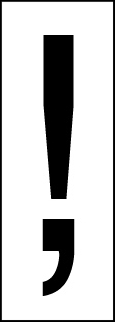After leaving you on a grammatical cliffhanger last time (kinda), at long last, here’s the second part of my foray into the world of obscure punctuation marks. Man, my life is exciting. Hold onto your hats people...
Percontation point: ⸮
Despite sounding like a place where teenagers went to snog in the 50s, the percontation point is actually a back-to-front question mark. And it might be my new favourite thing. You use it to show you’re being ironic or sarcastic. Nowadays the nearest equivalent is probably an exclamation mark in brackets, as in: ‘Yeah, blogs about punctuation marks are really interesting (!).’
Who came up with that? Henry Denham (a 16th-century printer and my new celebrity crush) first suggested the backwards question mark as a way to end a rhetorical question. Sadly this didn’t make it past the 17th century, but it was resurrected by a French poet in the 1890s who used it to show irony or sarcasm. In fact, loads of people have tried to come up with a punctuation mark to denote sarcasm (including the excellently named sarcmark) but nothing’s really stuck yet.
Exclamation comma: not available on keyboards so see picture below
I’m not a fan of the exclamation mark generally – they can make you sound a bit mental and shouty! And with the exclamation comma, you’re no longer limited to only sounding mental and/or shouty at the end of a sentence. It’s a bit hard to give you an example as it’s untypeable, so using an exclamation mark as a stand in, it would look something like this:
‘We’re so excited about this punctuation mark! we can’t end this sentence.’
The exclamation comma’s actually pretty young compared to most of its other obscure cousins, and was created in 1992 by three American inventors (called Leonard Storch, Haagen Ernst Van and Sigmund Silber), who even took out a patent on it. Fortunately for us that’s now expired, so feel free to be surprised in the middle of sentences with gay abandon (but only in handwritten documents).
But what if I want to ask a question in the middle of a sentence? Fret not – our three intrepid inventors also created an unholy union between the question mark and the comma. They called it – wait for it – the ‘question comma’ (it’s no ‘exclamoquest’ is it?). And it’s also not available on keyboards, sorry.
Dagger: †
Possibly not that obscure – you’ve probably seen this one in action as it’s generally used for a footnote if the writer’s run out of asterisks. It’s another oldie and is believed to have been invented by a Homeric scholar called Zenodotus (which is what I’ll be naming my next dog). You can also use it next to someone’s name to show they’re dead, in which case it’s called the ‘death dagger’. Ooh. (There are actually loads more uses for the dagger, and thankfully someone much cleverer than me has collated them on Wikipedia, if you’re interested. Or even still reading.)
Why’s it called a dagger⸮ (See what I did there?) The dagger has a second and, in my opinion at least, much more exciting name – the obelisk. This comes from the Greek word obeliskos, which doesn’t mean pointy statue, but ‘roasting spit’. Much better, right?
There’s also a double dagger, or ‘diesis’ (‡), and apparently even a triple one for people who don’t know that you can also use numbers for footnotes.
Guillemets: « »
Not to be confused with the birds, or the indie rock band, guillemets are possibly a bit of a cheat, because they’re foreign. They’re basically a more exotic version of our quotation marks and are used in loads of languages including French, Greek, Italian and Spanish. I only really included them here because I like the word (and I wanted to make that indie rock band joke in the first sentence).
Sheffer stroke: |
Not the prettiest of punctuation marks, the sheffer stroke is actually on your keyboard. I’ll wait here while you go find it.
Got it? It’s the one next to the z (and the cleanest key on my keyboard, as I don’t think I’d pressed it before today). It’s named after one Henry M Sheffer, author of the 1913 paper ‘Transactions of the American Mathematical Society’ where he provided an axiomatisation of Boolean algebras using the stroke, and proved its equivalence to a standard formulation thereof by Huntington employing the familiar operators of propositional logic (which are, of course, and, or and not). I absolutely, positively didn’t copy and paste this from Wikipedia.
It’s also, rather boringly, called a vertical bar, and is a variant of the slash, presumably for people who are just too lazy to make it slope.
The end?
That’s it for the moment for obscure punctuation. If you’re feeling a bit bereft (I know I am), then why not join me on my quest to come up with a new punctuation mark named after me? The Emmamark perhaps? Or the Wilkin Woggle (I don’t know what this is for, but I’m liking the name already)? Or, you know, go outside and talk to people or something.

